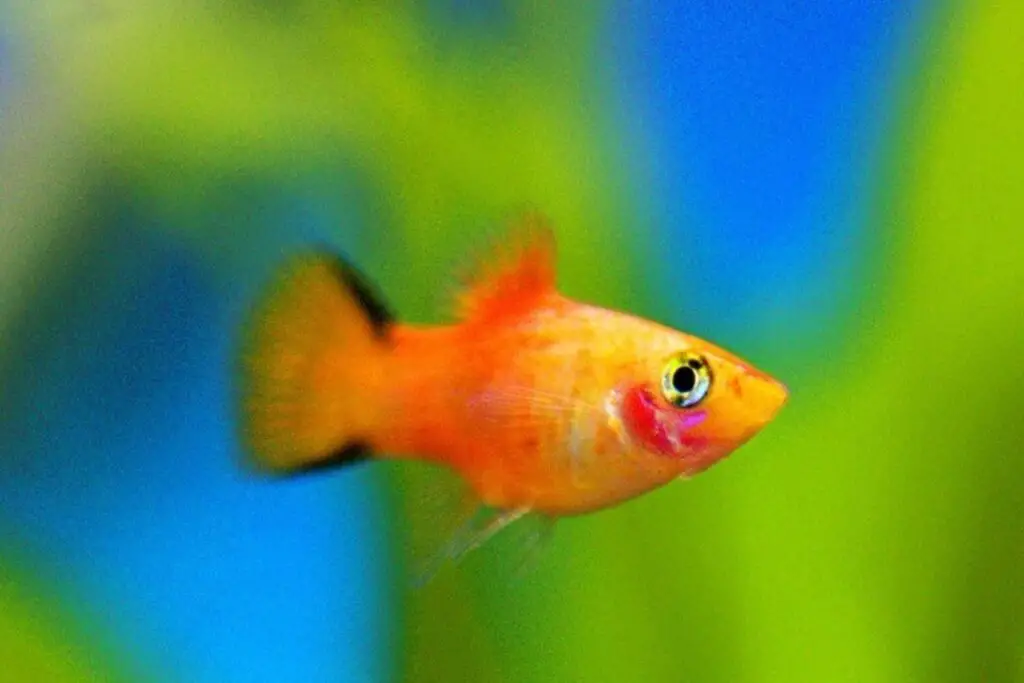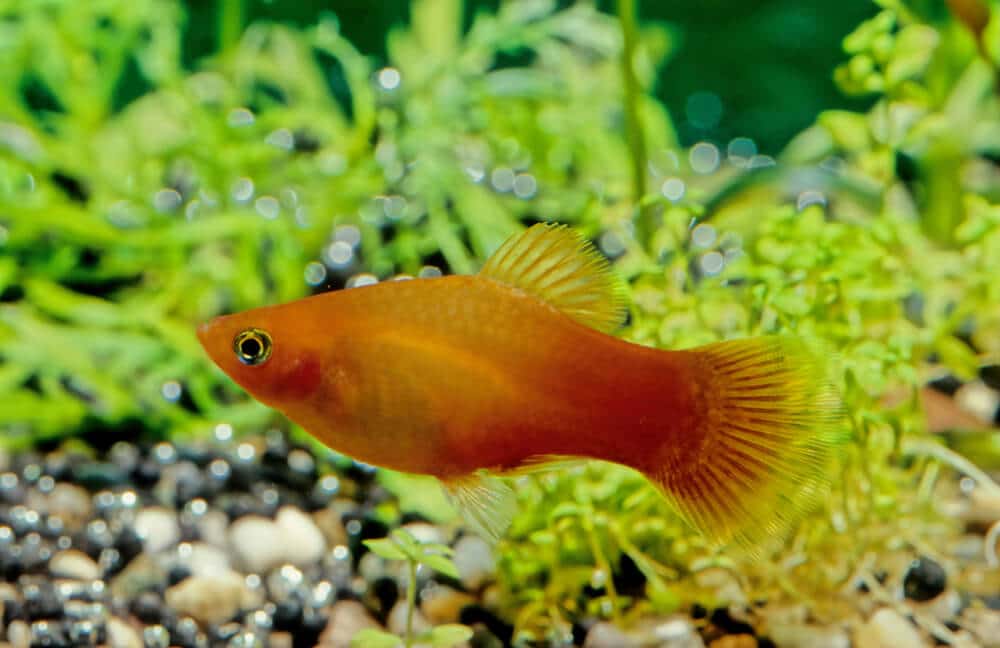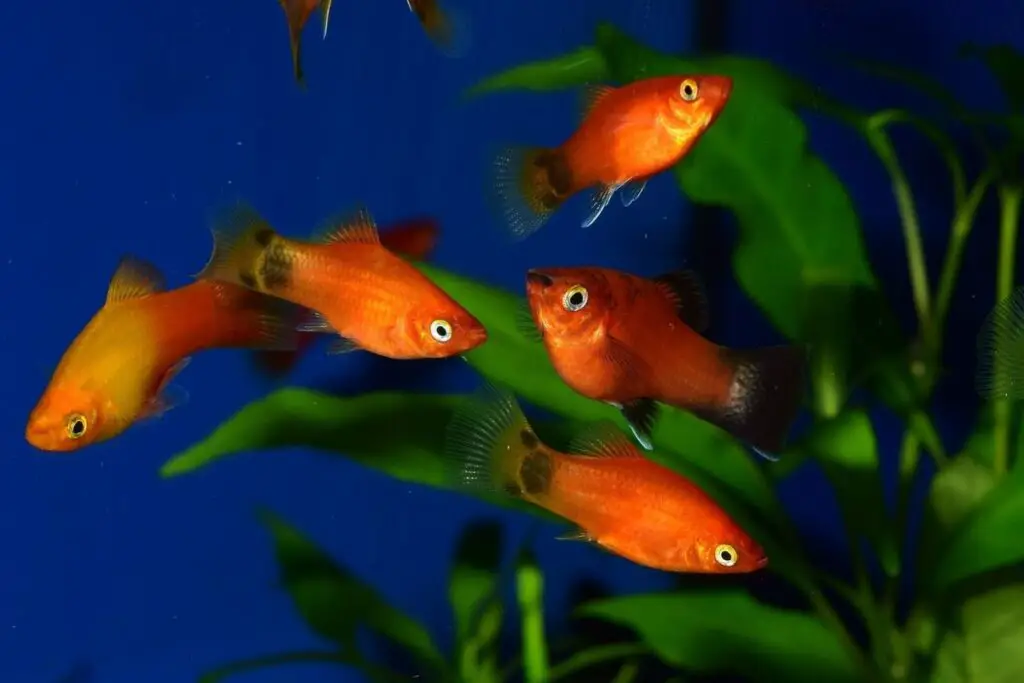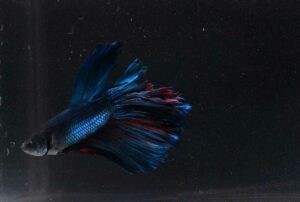When observing the behavior of Platys in your tank, do you often see them hiding? So, do they like to hide?
Platies enjoy and require hiding places in the aquarium to feel comfortable and secure. These areas serve as a habitat for them and might help them relax when they are attacked by other fish. However, if your Platy fish starts hiding from view one day, there may be several causes, including illness, predators, shy Platy fish, ammonia spikes, etc.
Continue reading to learn more regarding whether Platys like to hide, what the expected behavior of a Platys is, why your Platys may be hiding and more.
Do Platys Like to Hide?

Platys are actually known to like hiding in tank decor like underwater plants. Therefore, it is very common for your Platies to hide behind rocks, plants, or any other object in the tank.
Tropical fish, like the majority of living things, require safe and secure environments. In fact, if you want to see your Platies more frequently, you should provide them with extra hiding spots.
Platys use these hiding locations as a secure sanctuary. When something upsets them or they become terrified, they will flee to the hiding location to ensure that nothing can damage them.
When they are scared or worried, these hiding locations become extremely beneficial.
However, there are times when the Platies hide and refuse to come out, even when it is time to feed. This circumstance might be a little worrying, especially for novices.
If your Platies are continually hiding behind rocks, plants, or other objects and aren’t eating, it is essential to be aware that something is upsetting them.
What Is the Normal Behavior of Platys?
A Platy fish’s normal behavior is to have an energetic swimming style and to stay in the middle and upper levels of the tank. Platy fish also love hiding and exploring amid the plants.
Platy fish, mostly known as docile fish, are rarely hostile. However, males frequently harass females and can be aggressive against other males during breeding. As a result, Platys should be housed in a variety of shelters and hiding places.
Reasons Why Your Platys May Be Hiding

#1. Not Providing Your Platys with Adequate Hiding Places
One of the most critical considerations when starting a fishkeeping hobby is hiding areas. These areas assist in keeping your fish quiet and comfortable, as well as reducing stress.
As odd as it may seem, providing more hiding locations for your fish will result in less hiding behavior.
If your aquarium has few or no hiding places, your fish may exhibit heightened stress symptoms. This is because they don’t have anywhere in the tank to go when they need to be alone. Your fish may remain at the bottom of the aquarium in this instance.
#2. Platys Will Hide from Other Plays of Aggressive Fish
Like humans, when threatened, Platys fish get scared and, as a result, will attempt to hide from any aggressors.
For example, the alpha male mentality is a frequent trait among many species. The dominating male in this situation begins to bully the other guys.
Due to the general aggressive mentality of dominant male platies, other male platies may hide. By adding more females to the tank, you may prevent this issue.
You may also remove the dominating bully Platy from the others so that they have more freedom to wander about.
#3. Platys Will Hide When the Tank is Overcrowded
Overcrowding is another tank problem that can lead to fish hostility and hiding behaviors.
Although tropical fish are generally not aggressive, some species can become hostile towards other fish under certain circumstances. If there is one nasty fish in the tank bullying the other fish, the other fish may hide to protect themselves.
If there are too many fish in the tank or the male-to-female ratio is off, certain fish may become aggressive against other fish. They may pursue them or cause them damage.
As a result, your other fish may hide in order to defend themselves from the bullies.
You may either remove the bully fish from the tank or take efforts to lessen the bullies’ hostility to avoid this issue.
You can introduce two females for every single guy if the male-to-female ratio is off. As a result, there will be less hostility in the tank, which will assist with the hiding behavior.
Why Is My Platy Hiding Behind the Filter?
Hideouts and the tank’s decor, especially in a shared tank, are critical to the health and happiness of your fish. When there aren’t enough hiding spots in a tank, the fish may seek refuge everywhere they can, which could include the filter.
Unfortunately, this may be an issue since certain filters will suck up your fish’s fins, causing them to become trapped.
Small fish, such as Platys, can be drawn into the water filter’s input if the filter is too strong. To avoid this problem, provide plenty of hiding places for your fish to keep them away from the filter.
Hiding Behind the Filter Can Also Indicate that Your Platy’s Tank Water Quality is Poor
If you’re Platys is hiding behind the filter, it might also mean your water isn’t up to par. Use an aquarium water test kit to examine the water parameters in the tank if your Platys fish is hiding behind the water filter. To breathe, your fish consumes dissolved oxygen from the water in its tank.
As a result, the mechanical filtration system agitates the water near the filter output, increasing the surface area available for gaseous exchange and the amount of dissolved oxygen available to your fish.
When your tank is dirty, much of the oxygen produced by the filter system escapes through the water surface, leaving only the immediate vicinity of the filter with enough oxygen for your Platys fish.
I highly recommend you to read my detailed guide on why fish hide behind the filter for further info.
Do Platys Like to Be Alone?
While Platys appear to like the company of their own species, they seldom school together in a compact group unless you’re going to feed them. As a result, they may be kept alone but are known to do better in a group setting as long as they have enough swimming room.

A group of three to six Platys is an excellent place to start. Since males, like other livebearers, are continually trying to mate, keep at least two females for every one male to give the girls a respite.
What Decor Do Platies Like?
When designing the ideal Platy fish tank, you are advised that you strive to imitate their natural environment. To get the most significant outcomes, recreate their native surroundings.
Platy fish originally can be found in the wild in Mexico and Central America’s rivers, marshes, and warm springs.
Therefore, they can be found in bodies of water with sandy bottoms and thick vegetation. Since they’re on the tiny end of the fish size range, this dense foliage provides many places to hide and evade predators. Hardness and alkalinity are also common in their natural waters.
I also recommend you to watch my following video on hiding places for fish in tanks:
#1. What Kind of Substrate is Considered the Best for a Platy Fish?
Platys, unlike other fish, notably bottom-dwellers and cichlids, do not have specific substrate requirements. Platys, instead, prefer to stay in the center of the water column, so they don’t interact with your substrate too much.
Therefore, gravel, sand, bare bottom, or any other material will suffice as a substrate in your Platys tank. None of these substances will harm your fish in any way. However, if you had to force me to choose one substrate type, I’d go with smooth gravel.
#2. What Kind of Decorations are Considered the Best for a Platy Fish?
Platys don’t require caverns or bursting pirate treasure chests to hide in. If you place these creatures in a tank, they’ll most likely investigate and dart through the openings.
As a result, natural decorations such as driftwood or pebbles are recommended to re-create a tank that is similar to their original, natural surroundings. An even better option to consider are planted tanks.
#3. What Kind and How Much Illumination Do Platys Require?
Lighting needs, like most other aspects of platy maintenance, are straightforward. A few hours of natural light every day is more than enough.
If you maintain your platys in a planted tank, you’ll probably need 8-12 hours each day to keep your plants happy.
Make sure to give your plants and fish at least 8-12 hours of darkness every day so they can experience natural day-night cycles. Leaving the lights on all the time will stress your fish and will almost certainly result in algal problems.
How To Make My Platys Fish Normal and Make Them Hide Less?
#1. Removing Bully Fish from Your Platys Tank
When it is bullied by a more aggressive fish, a Platys will seek hiding places to avoid unwanted attention. Separating aggressive and passive fish can help to decrease this type of hiding.
Another way is to rearrange the tank’s décor to disrupt established territories, prompting each fish to reclaim its own space in the tank.
As a result, if you want your Platys to have tank mates, they should be calm and easygoing, as aggressive, or possessive ones can stress them out more. However, Platies are also known to return to their hiding area if they feel threatened by other fish in their surroundings.
In a communal tank, platies who get along rather than fight each other are preferred. Not only will this make it safer for your fish, but it will also make it more comfortable and pleasurable for you.
#2. Addressing Environmental Concerns in Your Platys Tank
It may sound counterintuitive, but if your fish tank lacks sufficient hiding locations, they may end up hiding in the same position more frequently.
Most fish, including Platys, are prey to larger fish in the wild. As a result, they like to be in areas with plenty of hiding spots.
If your fish feel exposed and have nowhere to hide, they will return to the same hiding location repeatedly. The obvious solution is to give them a lot more places to hide.
Your fish will find a variety of interesting hiding locations in caves, driftwood, and plants. These things will protect your fish and give them a variety of spaces to explore, ensuring that they do not become bored.
#3. Correcting Water Parameters in Your Platys Tank
In a Platy’s blood, Nitrite binds to hemoglobin in blood cells when nitrate levels in the water are high, reducing its ability to transport oxygen. This might cause your fish to suffocate. As a result, the fish begin to move to areas of the tank where breathing is easier.
You may quickly and effectively fix the problem of excess ammonia and nitrites in the water by doing repeated minor partial water changes. However, do not perform a total water change at once, as this may cause your fish to be shocked and perhaps die.
Replacing 20% of the water and repeating the procedure a few hours later is a better option. However, in extreme circumstances, you may need to change the water again the next day with this method.
Final Thoughts
Overall, if you maintain your Platys in a community fish tank with other calm, non-aggressive fish, it’s natural for them to hide when they’re stressed or unwell.
While all fish have a natural inclination to hide, platy fish hide more than other freshwater aquarium fish species. Their instinct tells them that things will improve if they’re protected in a secure and familiar area, they can call home.
Platies appreciate and require hiding spots in the aquarium to feel safe and comfortable. These places provide them with a habitat and may help them relax when they are attacked by other fish.
However, if your Platy fish starts hiding from view one day, there might be a number of reasons for this, including disease, predators, shy Platy fish, ammonia surges, and so on.
Hi! I’m Praveen Ghoshal, the founder of eFishkeeping.com. Inspired by my Dad, I got interested in fishkeeping when I was a kid. Since then, I have been involved with this hobby. Currently, I have 3 fish tanks at our home, and I enjoy this hobby with my full family. Read more about me here.




![Do Neon Tetras Die Easily? [Here’s The Truth!] do-neon-tetras-die-easily](https://efishkeeping.com/wp-content/uploads/2023/03/do-neon-tetras-die-easily-300x200.jpg)



